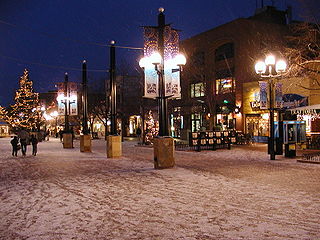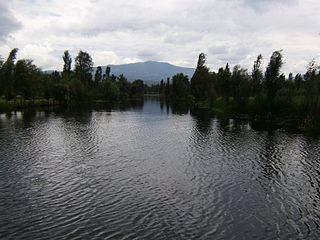Related Research Articles

Landscape architecture is the design of outdoor areas, landmarks, and structures to achieve environmental, social-behavioural, or aesthetic outcomes. It involves the systematic design and general engineering of various structures for construction and human use, investigation of existing social, ecological, and soil conditions and processes in the landscape, and the design of other interventions that will produce desired outcomes.
George Hargreaves is a landscape architect. Under his design direction, the work of his firm has received numerous national awards and has been published and exhibited nationally and internationally. He was an artist in residence at the American Academy of Rome in 2009. Hargreaves and his firm designed numerous sites including the master plan for the Sydney 2000 Olympics, The Brightwater Waste Water Treatment Facility in Seattle, Washington, and University of Cincinnati Master Plan.
Environmental design is the process of addressing surrounding environmental parameters when devising plans, programs, policies, buildings, or products. It seeks to create spaces that will enhance the natural, social, cultural and physical environment of particular areas. Classical prudent design may have always considered environmental factors; however, the environmental movement beginning in the 1940s has made the concept more explicit.

Garrett Eckbo was an American landscape architect notable for his seminal 1950 book Landscape for Living.
Ian L. McHarg was a Scottish landscape architect and writer on regional planning using natural systems. McHarg was one of the most influential persons in the environmental movement who brought environmental concerns into broad public awareness and ecological planning methods into the mainstream of landscape architecture, city planning and public policy. He was the founder of the department of landscape architecture at the University of Pennsylvania in the United States. His 1969 book Design with Nature pioneered the concept of ecological planning. It continues to be one of the most widely celebrated books on landscape architecture and land-use planning. In this book, he set forth the basic concepts that were to develop later in geographic information systems.

Hideo Sasaki was a Japanese American landscape architect.
Landscape planning is a branch of landscape architecture. According to Erv Zube (1931–2002) landscape planning is defined as an activity concerned with developing landscaping amongst competing land uses while protecting natural processes and significant cultural and natural resources. Park systems and greenways of the type designed by Frederick Law Olmsted are key examples of landscape planning. Landscape designers tend to work for clients who wish to commission construction work. Landscape planners analyze broad issues as well as project characteristics which constrain design projects.

Environmental art is a range of artistic practices encompassing both historical approaches to nature in art and more recent ecological and politically motivated types of works. Environmental art has evolved away from formal concerns, for example monumental earthworks using earth as a sculptural material, towards a deeper relationship to systems, processes and phenomena in relationship to social concerns. Integrated social and ecological approaches developed as an ethical, restorative stance emerged in the 1990s. Over the past ten years environmental art has become a focal point of exhibitions around the world as the social and cultural aspects of climate change come to the forefront.

Sustainable landscape architecture is a category of sustainable design concerned with the planning and design of the built and natural environments.
Jardines del Pedregal or simply El Pedregal is an upscale residential colonia (neighborhood) in southern Mexico City hosting some of the richest families of Mexico. It is also known as the home to the biggest mansion in the city. Its borders are San Jerónimo Avenue and Ciudad Universitaria to the north, Insurgentes Avenue to the east and Periférico to the south and west. Its 510 hectares were a major real estate project undertaken by Mexican modernist architect Luis Barragán.

Ciudad Satélite, commonly known as Satélite, is an upper-middle and upper-class neighborhood located 14 KM northwest of Mexico City's Historic Center, in Naucalpan, in the western part of Greater Mexico City. Officially, the name corresponds exclusively to the homonym neighbourhood, Ciudad Satélite, founded circa 1957. But over time, its surrounding area—including upper-middle class neighbourhoods like Lomas Verdes, Echegaray, Paseos del Bosque or San Mateo, alongside adjacent municipalities Atizapán de Zaragoza and Tlalnepantla de Baz—has also become collectively known as "Satélite", due to its prominence as both an economically and socially dynamic area.
James Corner is a landscape architect and theorist whose works exhibit a focus on "developing innovative approaches toward landscape architectural design and urbanism." His designs of note include Fresh Kills Park on Staten Island and the High Line in Manhattan, and Domino Park in Brooklyn, all in New York City.

Luis Barragán House and Studio, also known as Casa Luis Barragán, is the former residence of architect Luis Barragán in Miguel Hidalgo district, Mexico City. It is owned by the Fundación de Arquitectura Tapatía and the Government of the State of Jalisco. It is now a museum exhibiting Barragán's work and is also used by visiting architects. It retains the original furniture and Barragán's personal objects. These include a mostly Mexican art collection spanning the 16th to 20th century, with works by Picasso, Diego Rivera, José Clemente Orozco, Jesús Reyes Ferreira and Miguel Covarrubias.

The School of Architecture at UNAM is one of the leading schools of architecture and design in Mexico. It offers undergraduate and postgraduate studies in architecture, landscape architecture, urbanism and industrial design.
Agustín Landa Verdugo was a Mexican architect and urban planner, born in Mexico City. He studied architecture in the National University of Mexico. In 1945 he established a firm with his brother Enrique, with whom he designed hundreds of public and private buildings during four decades of partnership. The firm's work distinguished itself by its modern language and the efficiency and economy of the solutions it proposed.
Enrique Carral Icaza was a Mexican architect. He was born in Mexico City.

Xochimilco Ecological Park and Plant Market is a natural reserve or park, with a 13-hectare (32-acre) plant market, the largest in Latin America. The park and market are located in the southern Mexico City borough of Xochimilco, about 23 km south of the historic center of the city. The park was designed by Mario Schjetnan. The park was inaugurated in 1993, on chinampas which had been previously declared as part of a World Heritage Site. However, the area's ecology was badly degraded, and the park was established in order to revitalize and preserve the ecosystem. Success has been mixed. While much of the wetlands have been recharged, pollution and illegal settlements in the area remain as threats. As the park needs to be self-sustaining economically, there are a number of ways that the park raises money. One of the best known of these is the Xochimilco or Cuemanco Plant Market, which rents stalls to ornamental plant producers/sellers near the main entrance of the park.

Kongjian Yu, is a landscape architect and urbanist, writer and educator, commonly credited with the invention of Sponge City concept, and winner of the International Federation of Landscape Architects’ Sir Geoffrey Jellicoe Award in 2020. Received his Doctor of Design Degree from Harvard Graduate School of Design in 1995, Doctor Honoris Causa from Sapienza University of Rome in 2017 and Honorary Doctorate from Norwegian University of Life Sciences in 2019, Yu was elected to the American Academy of Arts and Sciences in 2016.

Bicentennial Park is a park in Mexico City. It is located in the western part of the city, on the boundary of Azcapotzalco and Miguel Hidalgo. It was built as part of the Celebration of the Bicentennial of the Independence of Mexico and inaugurated by then President Felipe Calderón on November 7, 2010. This park is ten times larger than the Plaza de la Constitución in downtown Mexico City and the second largest "lung" in the city.
References
- ↑ Thompson, William. "Landscape as Myth and Culture." Landscape Architecture, January 1994, 72-75.
- 1 2 3 4 McDonald, Sally. "Interview- Mario Schjetnan: With Mexico in Mind." Landscape Design, September 2002, 12-14.
- 1 2 3 4 5 Beardsley, John. Ten Landscapes Mario Schjetnan. Edited by James Grayson Trulove. Gloucester, Massachusetts: Rockport Publishers, Inc., 2002.
- Beardsley, John. "A Word for Landscape Architecture." Harvard Design Magazine 12 (2000): 1–5.
- Gilens, Todd. "Ten Landscapes: Mario Schjetnan." [book review] Landscape Journal 2 (2003): 155–156.
- Martignoni, Jimena. "Cultural Statement: A 'getaway' house honors both the past and present of Mexico." Landscape Architecture. May 2007, 52–58.
- Schjetnan, Mario. "Bracken Lecture Series: Mario Schjetnan." [video recording] The Pennsylvania State University, March 18, 2006.
- Thompson, William. "Cultural Simplicity." Garden Design, July 1992, 52–55.
- Mambo – Proyectos